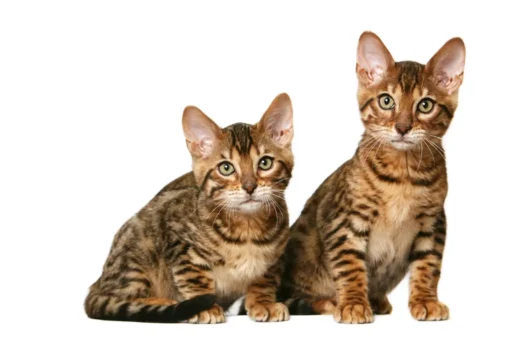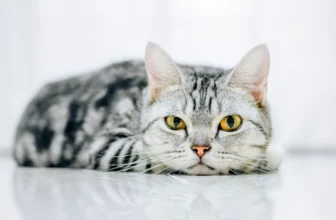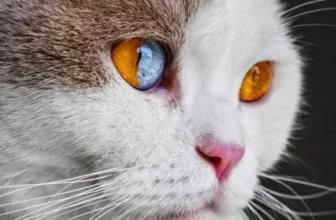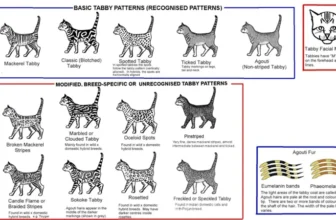As cat owners, we all want our furry friends to be healthy and happy. One crucial aspect of cat health is maintaining a healthy body weight. This is especially important for California Spangled cats, a breed known for their athleticism and energy. However, it can often be difficult to determine if your cat is at a healthy weight, let alone maintain it. In this article, we will explore why it is important to maintain a healthy body weight in California Spangled cats, how to determine if your cat is obese, and share some tips for keeping your cat at a healthy weight.
The Consequences of Obesity in California Spangled Cats
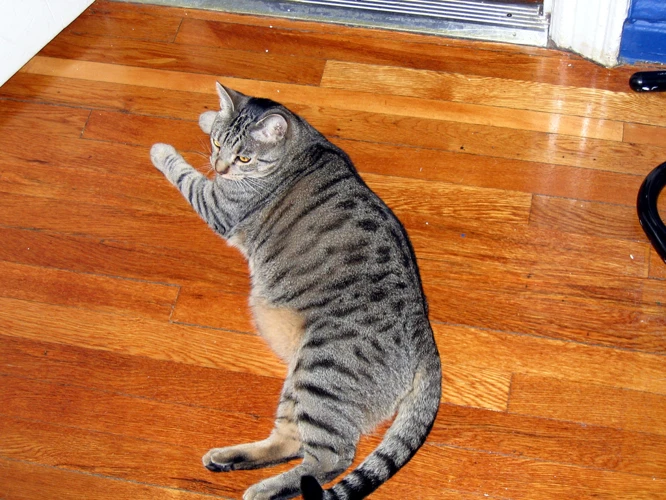
As a dedicated California Spangled cat owner, it is important to understand the consequences of obesity on your furry friend’s health. Maintaining a healthy body weight is crucial to ensure that your pet lives a long and fulfilling life. Unfortunately, obesity in California Spangled cats can lead to a number of health issues that could have a profound impact on their overall well-being. Joint problems, diabetes, and a shortened lifespan are just a few examples of the dangers associated with obesity. To learn more about the different body types of California Spangled cats, check out this article on California Spangled cat body types. Let’s explore the consequences of obesity a bit further.
Joint Problems
Excessive weight can also lead to joint problems in California Spangled cats. When a cat is carrying too much weight, their joints and bones are put under a lot of stress. This can lead to several issues such as arthritis and limited mobility.
Arthritis: When a cat has arthritis, it means that the joints are inflamed and painful. Arthritis can cause a cat to be less active, which can lead to further weight gain, starting a vicious cycle. Obese cats have a higher risk of developing arthritis, and it can worsen if the cat does not lose weight.
Limited mobility: Excessive weight can also make it hard for a California Spangled cat to move around properly. This can lead to limited mobility and affect activities such as jumping or running.
It is essential to keep your cat’s weight in check and prevent joint problems. Regular exercise can help strengthen the muscles and bones and improve joint health. In the next section, we will discuss some tips for maintaining a healthy body weight in California Spangled cats.
To learn more about different body types in California Spangled cats, refer to our article on 5 California Spangled Cat Body Types or read about California Spangled Cat Body Types.
Diabetes and Other Health Problems
The consequences of obesity in California Spangled cats can be severe, including the risk of developing various health problems. One of the most common health issues associated with obesity is diabetes, which can be life-threatening for cats.
Diabetes is a condition in which the body cannot regulate blood sugar levels, leading to elevated glucose in the bloodstream. Obese cats are more likely to develop this condition, as excess weight can cause insulin resistance, a key factor in feline diabetes.
Other health problems associated with obesity in California Spangled cats include:
- Urinary tract disease: Overweight cats are at a higher risk of developing urinary tract issues, such as bladder stones or infections.
- Heart disease: Obesity in cats can cause heart disease, which can lead to heart failure or even sudden death.
- Arthritis: Extra weight can put additional stress on a cat’s joints, leading to arthritis or other joint problems.
- Respiratory problems: Obese cats may experience respiratory difficulties due to the pressure exerted on their lungs by excess fat.
It is important to note that these health problems can not only be painful and debilitating for the cat, but they can also add up to expensive vet bills and decrease their quality of life.
To help prevent these health problems, it’s crucial to maintain a healthy weight for your California Spangled cat by following the tips mentioned in this article. If you’re unsure what weight is appropriate for your cat, consider checking out our article on California Spangled cat body types to get a better idea.
Shortened Lifespan
Obesity in California Spangled cats not only leads to joint problems and diabetes, but it can also result in a shortened lifespan. In fact, overweight cats are more likely to develop serious health conditions that can significantly reduce their lifespan.
Here are some of the health conditions that can shorten the lifespan of an obese California Spangled cat:
| Health Condition | Effect on Lifespan |
|---|---|
| Heart Disease | Obesity is a leading cause of heart disease in cats. It can increase the risk of heart failure, heart attack, and other serious heart conditions. These conditions can significantly reduce a cat’s lifespan. |
| Respiratory Problems | Obese cats are more likely to develop respiratory problems such as asthma and bronchitis. These conditions can be life-threatening and can reduce a cat’s lifespan if not properly managed. |
| Cancer | Studies have shown that overweight cats are more likely to develop certain types of cancer, such as lymphoma and mammary cancer. These cancers can be aggressive and can significantly reduce a cat’s lifespan. |
| Urinary Tract Disease | Obesity can increase the risk of urinary tract disease, which can be painful and life-threatening. Untreated urinary tract disease can lead to kidney damage and even death. |
It is important to remember that maintaining a healthy body weight in California Spangled cats is crucial for their overall health and wellbeing. By preventing obesity and the associated health problems, owners can help their cats live a longer and happier life.
How to Determine if Your California Spangled Cat is Obese
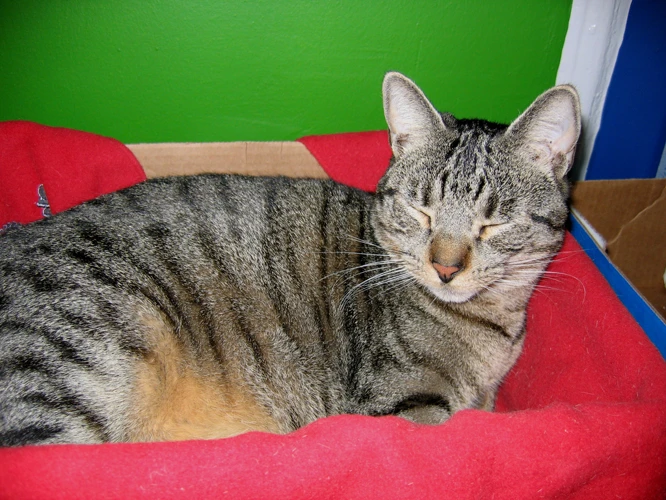
As cat owners, it’s essential to keep an eye on our furry friend’s weight, as obesity can lead to several health complications. But how can you tell if your California Spangled cat is overweight? By assessing their body condition score, measuring their waistline, and consulting with your veterinarian, you can determine if your cat needs to shed a few pounds. It’s crucial to identify if your cat is obese because taking action early on can prevent health issues in the future. Let’s explore the best ways to determine if your feline friend is carrying too much weight.
Consider Body Condition Score (BCS)
One of the most effective ways to determine if your California Spangled cat is maintaining a healthy body weight is to assess their body condition score (BCS). BCS is an easy-to-use scale that assesses your cat’s body fat percentage based on their overall appearance and physical characteristics. It helps you identify if your furry friend is overweight or underweight. This technique is commonly used by veterinarians to monitor the health of cats.
So, how do you use the body condition score?
The BCS system utilizes a scale from 1 to 9, with 1 being emaciated and 9 being obese. Ideally, your California Spangled cat should be between 4 and 5, which indicates that they are at a healthy weight.
How do you assess your cat’s body condition score?
To assess your cat’s BCS, you need to evaluate three important aspects: ribs, waist, and overall appearance. The following table summarizes the ratings for each score:
| BCS Score | Ribs | Waist | Overall Appearance |
|---|---|---|---|
| 1: Emaciated | Ribs visible and easy to feel, with no fat covering | Abdominal tuck-up | Bones and other prominent features visible |
| 2-3: Underweight | Ribs visible and easy to feel but with slight fat covering | Noticeable abdominal tuck-up | Minimal fat covering with prominent bones |
| 4-5: Ideal | Ribs easy to feel with slight fat covering | Visible waist | Healthy weight with no prominent bones |
| 6-7: Overweight | Ribs slightly difficult to feel due to fat covering | Noticeable waist disappears behind fat | Increased fat covering with a round appearance |
| 8-9: Obese | Ribs very difficult to feel due to excessive fat | No waist visible | Significant increase in fat covering, with an overall round appearance |
What should you do after assessing your cat’s BCS?
If your California Spangled cat’s BCS is not within the ideal range, it’s time to start taking measures to help them lose or gain weight. Talk to your veterinarian to learn more about the specific dietary and exercise guidelines needed to get your cat back on track. Regular check-ups can help you monitor your cat’s progress towards a healthier weight and avoid any health complications associated with obesity or malnourishment.
Measure Your Cat’s Waistline
Measuring your California Spangled cat’s waistline can be another effective way to determine if your cat has gained too much weight. By measuring the waistline, you can get an idea of how much excess fat your cat is carrying around its abdomen, which can increase the risk of health issues.
Here are the steps for measuring your cat’s waistline:
- Find the ribs: Run your hands along your cat’s sides, and locate the ribs. You should be able to feel each rib without pressing too hard.
- Locate the waist: Once you have found the ribs, identify the point where they end and where your cat’s waist begins. This point should be narrower than the ribs and the hips.
- Measure the waist: Use a flexible tape measure to measure your cat’s waistline at the narrowest point, just behind the ribs. Make sure the tape measure is not too tight or too loose when taking measurements.
It’s important to keep track of your cat’s waist measurement over time and take action if you notice any increase in size. A bigger waistline could indicate a need for adjustments to your cat’s diet and exercise routine. By regularly measuring your cat’s waistline, you can help keep your feline friend healthy and active for years to come.
Ask Your Vet
When it comes to maintaining a healthy body weight for your California Spangled cat, seeking the advice of a qualified veterinarian is crucial. Your vet will be able to provide you with a comprehensive assessment of your cat’s weight and health status. Here are some steps you can take when you consult with your vet:
- Bring Up Your Concerns: When you visit your vet, express any concerns you have about your cat’s weight. Describe any changes in your cat’s eating habits, activity levels, and overall demeanor. Share your observations of your cat’s appearance and behavior, and ask your vet to evaluate your cat’s weight and suggest a course of action.
- Understand Your Cat’s Body Condition Score (BCS): BCS is a numerical scoring system used to evaluate a cat’s body composition. Your vet will assign a score based on your cat’s overall appearance and physical condition, including their ribs, waistline, and overall body shape. Understanding your cat’s BCS will help you determine if your cat is overweight or underweight.
- Discuss Diet and Feeding Habits: Your vet will be able to recommend a balanced diet and feeding habits that are appropriate for your cat’s age, weight, and overall health. They will advise on the ideal calorie intake for your cat and recommend a feeding schedule that will help maintain a healthy weight.
- Create a Plan: Based on your cat’s BCS and overall health, your vet will help you create a personalized plan for maintaining a healthy weight. They will suggest changes in diet, feeding habits, and exercise routines. They may also recommend specific activities or games to help your cat stay active and healthy.
Remember, maintaining a healthy body weight is essential to keeping your California Spangled cat healthy and happy. By working with your vet to create a personalized plan, you can ensure that your cat receives the best possible care.
Tips for Maintaining a Healthy Body Weight in California Spangled Cats
As a California Spangled cat owner, you play a crucial role in helping your feline companion maintain a healthy body weight. While it may seem simple, feeding your cat a balanced diet and ensuring they get enough exercise can be challenging without the right tools and knowledge. Fortunately, with these practical tips, you can help your cat achieve and maintain a healthy weight, and prevent the negative consequences of feline obesity.
Feed a Balanced Diet
Maintaining a balanced diet is a vital component in achieving optimal health for your California Spangled cat. A balanced diet should contain all the necessary vitamins, minerals, and nutrients that your cat’s body needs. It’s essential to feed your California Spangled cat a high-quality, nutrient-rich, and well-balanced diet to prevent health problems caused by obesity.
To ensure your cat’s diet is well-balanced, it’s best to consult with a veterinarian or an animal nutritionist. They can provide you with the right information regarding the ideal food proportion for your California Spangled cat. You can also consider feeding your feline companion with commercially-prepared, nutritionally-complete cat food available in many forms, such as kibbles, canned food, or raw food.
Here are some essential nutrients that your California Spangled cat’s diet should contain:
| Nutrient | Function | Food Sources |
|---|---|---|
| Protein | Builds and repairs muscle tissues | Meat, poultry, fish, eggs, and dairy products |
| Fat | Provides energy and aids nutrient absorption | Fatty cuts of meat, fish, and plant-based oils |
| Vitamins | Supports a healthy immune system and organ functions | Fruits, vegetables, and a well-balanced commercial diet |
| Minerals | Regulates body fluids and aids in many bodily functions | Fruits, vegetables, and a well-balanced commercial diet |
| Fiber | Helps regulate digestion and aids in weight management | Whole grains, fruits, and vegetables |
By feeding your California Spangled cat a balanced diet, you’ll ensure they receive the necessary nutrients they need while reducing their chances of becoming overweight or obese. Remember to introduce changes in diet gradually, avoid overfeeding your cat, and always provide access to fresh water.
Measure Portions
It’s essential to measure your California Spangled cat’s food portions to maintain a healthy body weight. Without measuring, it can be easy to overfeed your cat, leading to obesity and related health problems. Below are some tips to help you measure your cat’s portions effectively:
Use a Measuring Cup: Using a measuring cup to portion out your cat’s food is a reliable method. Measure the amount of food recommended by your veterinarian by using a 1/4 or 1/3 cup measuring cup. Make sure to be consistent with the amount you are feeding your cat.
Read the Label: Check the food label to see how much you should be feeding your cat according to their weight. The suggested portion sizes should be a guide, but be sure to adjust them according to your cat’s individual needs.
To keep things organized and to avoid overfeeding, consider using a table. Here’s an example of how you can make a portion control table:
| Meal | Cat’s Weight | Cups |
|---|---|---|
| Breakfast | 6-10 lbs | 1/4 cup |
| 11-15 lbs | 1/3 cup | |
| Lunch | 6-10 lbs | 1/4 cup |
| 11-15 lbs | 1/3 cup | |
| Dinner | 6-10 lbs | 1/4 cup |
| 11-15 lbs | 1/3 cup |
Keep in mind that the table above is just a suggestion, and you should always consult with a veterinarian to determine the right portion sizes for your cat’s specific needs. By measuring your cat’s food carefully, you can help them maintain a healthy body weight and avoid potential health problems down the line.
Encourage Exercise
One of the most effective ways to maintain a healthy body weight in California Spangled cats is to encourage regular exercise. Regular physical activity can play a crucial role in helping your cat to maintain a healthy weight and prevent obesity-related health problems.
Why is exercise important for California Spangled cats?
Regular exercise can help your California Spangled cat to stay healthy and fit in many ways. For starters, exercise can help to burn excess calories and prevent weight gain. Additionally, exercise can help to build strength and endurance, improve muscle tone, and enhance overall health and well-being. Regular exercise can also promote mental stimulation and reduce boredom, which can lead to destructive behavior in some cats.
How much exercise do California Spangled cats need?
The amount of exercise that your California Spangled cat needs will depend on several factors such as age, weight, and overall health. Generally, cats should get at least 20-30 minutes of physical activity per day, but some cats may need more or less depending on their individual needs.
What are some ways to encourage exercise in California Spangled cats?
There are many ways to encourage your California Spangled cat to get more exercise. Some options include:
| Activity | Description |
|---|---|
| Interactive toys | Provide toys that your cat can play with, such as puzzle feeders, laser pointers, and wand toys. |
| Climbing structures | Provide your cat with climbing structures, such as cat trees and shelves, to encourage climbing and jumping. |
| Outdoor time | If it is safe to do so, consider allowing your cat to spend time outside in a secured area. This can give your cat more space to explore and play. |
| Playtime with humans | Set aside time each day to play with your cat, using toys or simply engaging in interactive play. |
What should you do if your California Spangled cat is resistant to exercise?
If your California Spangled cat is resistant to exercise, there are several things that you can do to encourage them to be more active. Consider starting with shorter play sessions and gradually increasing the duration over time. You can also try offering high-value treats or rewards to your cat during playtime to make it more fun and enjoyable. It may take some patience and persistence, but with time and effort, you can help your cat to become more active and healthy.
Consider a Weight-Loss Plan
It’s important to remember that drastic changes to your California Spangled cat’s diet or exercise routine can be harmful, so it’s important to approach weight loss gradually and with the guidance of a veterinarian. Here are some tips to consider when creating a weight-loss plan:
| Tip | Description |
|---|---|
| 1. Implement gradual changes | Don’t attempt to drastically reduce your cat’s food intake or increase their exercise in a short period of time. This can lead to health problems and may not be sustainable. |
| 2. Choose a specialized diet | Consider switching to a weight-management formula cat food that is designed to help your cat lose weight. Look for a high-protein, low-carbohydrate diet. |
| 3. Measure food portions precisely | Use a measuring cup to ensure that your cat is receiving the appropriate portion sizes. Avoid free-feeding, as this can lead to overeating. |
| 4. Create a feeding schedule | Instead of leaving food available to your cat constantly, consider feeding them at set times during the day. This will help prevent overeating and assist with portion control. |
| 5. Encourage playtime | Incorporate playtime into your cat’s routine to encourage exercise. Use interactive toys or laser pointers to provide mental and physical stimulation. |
| 6. Monitor progress with your vet | Regularly schedule check-ups with your veterinarian to monitor your cat’s weight loss progress and make adjustments to the plan as necessary. |
By implementing these tips and creating a weight-loss plan with your veterinarian, you can help your California Spangled cat achieve and maintain a healthy body weight. Remember to approach weight loss gradually and with care to ensure your cat’s overall health and well-being.
Conclusion
In conclusion, maintaining a healthy body weight is crucial for the well-being and longevity of California Spangled cats. Obesity can lead to a variety of health problems, such as joint issues, diabetes, and a reduced lifespan. Therefore, it’s important to take preventive measures that can help keep your cat at a healthy weight.
One way to determine if your cat is overweight is by using the Body Condition Score (BCS) system, which takes into account the cat’s overall appearance and body shape. In addition, measuring your cat’s waistline and consulting with a vet can also provide valuable insights.
There are several tips that can help your California Spangled cat maintain a healthy weight. Feeding a balanced diet that meets your cat’s nutritional needs is key. Measuring portions can help prevent overfeeding, and encouraging exercise can help keep your cat active and healthy. If your cat is already overweight, consider a weight-loss plan that is safe and effective.
Remember, obesity in California Spangled cats can have serious consequences, and it’s up to the pet owner to take action to prevent it. By following these tips and monitoring your cat’s weight and health, you can help ensure that your feline friend lives a long, happy, and healthy life.
Frequently Asked Questions
What is a healthy body weight range for California Spangled cats?
A healthy body weight range for California Spangled cats is typically between 8 and 11 pounds, but this can vary depending on the specific cat’s age, sex, and activity level.
Can overfeeding treats cause obesity in California Spangled cats?
Yes, overfeeding treats can contribute to obesity in all cats, including California Spangled cats. Treats should be given in moderation and as part of a balanced diet.
What are the benefits of maintaining a healthy body weight in California Spangled cats?
Maintaining a healthy body weight in California Spangled cats can help prevent joint problems, diabetes, other health problems, and can also extend their lifespan.
What kind of exercise is good for California Spangled cats?
California Spangled cats enjoy activities that allow them to use their natural hunting and chasing instincts. Providing them with toys that mimic prey, such as balls or feather wands, can encourage them to exercise.
Can California Spangled cats develop eating disorders?
While rare, California Spangled cats, like all cats, can develop eating disorders such as binge eating, food aggression, or other compulsive behaviors around food.
Can spaying or neutering affect a California Spangled cat’s weight?
Spaying or neutering generally does not affect a California Spangled cat’s weight directly. However, the procedure can cause a decrease in activity level, which could lead to weight gain if their diet is not adjusted accordingly.
How often should a California Spangled cat be weighed?
A California Spangled cat should be weighed at least once a year during a routine check-up, but more frequent weigh-ins may be necessary if they are undergoing a weight-loss plan.
Are there any supplements that can help a California Spangled cat maintain a healthy body weight?
While there are no supplements specifically designed to help cats maintain a healthy weight, some supplements, such as omega-3 fatty acids, may have health benefits that could indirectly support weight management.
What should I do if my California Spangled cat is overweight or obese?
If your California Spangled cat is overweight or obese, you should consult with your vet to create a weight-loss plan that includes a balanced diet, appropriate portion sizes, and a regular exercise routine.
Can a California Spangled cat’s weight fluctuate throughout the year?
Yes, a California Spangled cat’s weight can fluctuate throughout the year, especially around the holidays or other times when they may receive more treats or food. Regular weigh-ins and adjusting the diet accordingly can help prevent fluctuations.

